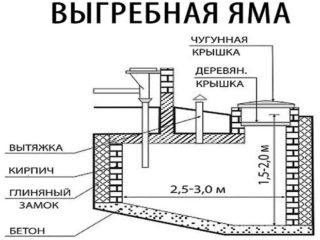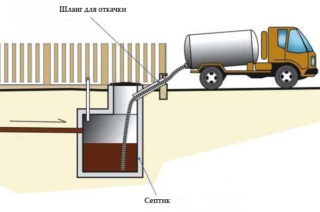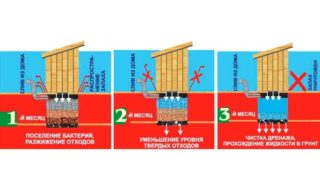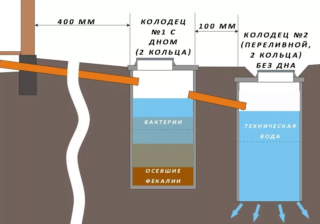A cesspool is a mandatory component of an autonomous sewage system for most owners of suburban areas. Therefore, the problem of its quick filling often arises. Literally a year after the start of operation of the system, the owner notices that the water does not leave the cesspool even with regular pumping of wastewater. You need to deal with the problem, otherwise the sewage system will completely fail.
The main reasons for water retention in a cesspool

To understand why the receiver does not absorb water, you need to know its design. Typically, a cesspool is a reservoir formed directly in the ground. In the best case, a drainage bottom is made for it from fine-grained rubble, river sand and broken bricks. In the worst case, they simply leave the bottom and walls unpaved. In both cases, it is assumed that the drains will gradually be absorbed (seep) into the soil from the side of the walls and, in greater mass, through the bottom. Over time, however, the absorbency of the earth / drainage bottom will seriously decrease. This happens for the following reasons:
- Silting of the bottom - the formation of fecal sludge in the lower part of the pit. It forms a crust that does not allow water further into the soil.
- The formation of fatty deposits on the walls and in the lower part of the pit. It also prevents water from entering the ground.
- Freezing of soil in winter. If the cesspool does not absorb water precisely at subzero temperatures, then we are talking about freezing the system.
- Insufficient receiver volume. Perhaps more people have recently been using the sewage system, additional household washing appliances have been connected. This leads to a quick filling of the reservoir and the need for its frequent pumping.
According to sanitary standards, the formation of a simple pit on the site causes irreparable environmental damage to the environment. Such actions are criminally punishable. Therefore, it is desirable to have a pit with a sealed bottom, walls and an overflow chamber.
How to deal with poor water drainage

You need to cope with the problem depending on its causes. In this case, the actions will be radically different.
Silting the pit
You will need a high-quality wash of the muddy crust. To do this, you need to rent special equipment (sewer-sludge pump). Sequencing:
- Primary pumping out of waste water from the receiver.
- Washing out silt at the bottom under high water pressure.
- Parallel cleaning of the walls and bottom of the pit with brushes from accumulated dirt.
- Another tank flushing and sludge pumping.
Additionally, you can use bacteria to soften the muddy crust. But it is worth remembering that biological products work in a humid environment subject to positive temperatures.
When cleaning the pit, it is advisable to thoroughly rinse the entire collector in order to remove the formed sludge from its walls.
The formation of a fatty film on the walls and bottom of the pit

In order to be able to get rid of water in the cesspool in a natural way, you need to take care of the absence of fat in the drains. It is formed as a result of the ingestion of human sweat and food waste into the sewer system. In combination with cold water (under conditions of outdoor temperatures), the fat gradually thickens, clogs the pores of the soil. From this, water ceases to go into the soil.
You can also deal with the problem by the method of washing, plus the use of bacterial or chemical preparations.
The former actively corrode fecal silt and fat, decomposing them into organic matter (compost) and water. As a result, the volume of effluent is seriously reduced, and the need to pump out the pit frequently disappears. But biological products reduce or completely neutralize their activity if the sewage contains impurities of household chemicals (powders, detergents, cleaning agents). Better to use bacteria in the toilet pit. In this case, it is necessary to observe the temperature regime (bioadditives work in warmth) and the volume of water in the receiver. The preparations "Vodogray", Microbec have proven themselves well. They not only decompose fecal matter, but also recycle toilet paper, food peels.
Chemicals are produced on the basis of nitrate oxidants, formaldehyde or ammonium compounds. All drugs actively affect fat, fecal sludge, processing and destroying them. But there are a number of things to be aware of before using chemicals in the pit. The safest are nitrate oxidants. The sludge formed after them can be used as compost. Chemicals based on ammonium compounds work only at positive temperatures.
Formaldehydes, although they kill odors, fecal silt and fat, completely destroy ("deaden") the soil within a radius of 7-10 meters from the pit. Even a weed will not germinate on such soil. Drugs in this group are used extremely rarely.
Freezing soil
If it is found that water from the sewer receiver does not go well in winter, it is important to ensure high-quality heating of the communication elements. And you need to start with the pipeline. It is well insulated, and for a greater effect, an electric cable is run along the entire length of the tube.
In the pit itself, it is first desirable to warm up the drains. To do this, you can pour in several tens of liters of hot water. Then take a metal rod, in height exceeding the depth of the receiver. They hammer it in the corner of the pit into the very soil through the silt. A stripped electrical wire is thrown over the rod and plugged into the network with a plug. Here, the frozen ground will work as an excellent conductor of current. Melt ground will restrict his movement further. Thus, the drains will warm up in the pit along with the soil, and the water will flow freely.
It will take about a day to warm up a pit with a volume of 3-4 m3.
Small sewerage tank volume

If more people use the pit, it will fill up faster. In this case, it is necessary to increase the useful volume of the receiver. To do this, it is enough to form another tank next to it and connect them with an overflow pipe. In parallel, the bottom of the first receiver can be concreted. Make a drainage bottom in the second chamber. The result is a complete septic tank that is less harmful to the environment. The effluents in it are purified by 68-70%.
Prevention of siltation of a sewer pit
To reduce the frequency of pumping out of the sewer receiver, to prevent the formation of fat and sludge on its walls, it is important to take preventive measures.
- Timely pumping of sewage from the pit. Especially if the sewage system is preserved for the winter.
- Regular high-pressure flushing of the sides and bottom of the receiver. This should be done at least once a year. Ideally, every six months.
- In summer, it is advisable to use bacteria or chemicals that will eliminate the odor and prevent the formation of a fatty film in the pit.
- When installing a sewer receiver, it is important to take into account the depth of soil freezing in the region. If necessary, the tank must be insulated.
Compliance with these simple measures allows you to ensure the reliable functioning of an autonomous sewage system for more than a dozen years.









sulfuric acid into the pumped out pit of 20 liters and the problems are solved
you need to make not a cesspool, but a single-chamber septic tank. This is the same cesspool, but the bottom and walls of which are waterproofed, and treated wastewater (clarified water) is removed from its middle part into the ground or ditch
Plant a birch nearby and there will be no all these problems.
The most idiotic recommendation is to warm up the cesspool with a bar connected to the network. If we throw a phase on a grounded bar - we get a short circuit, if we throw zero on the bar - part of the consumed electricity will go into the ground in addition to the meter, which will raise questions from the housing and communal services. Alternatively, a heating cable can be used to heat / heat the waste pit.
What is the pit? Dry closet.
How to quickly resolve the issue ???
water does not leave the sink is in a pipe that goes into a drain pipe in a private house. This was not the case before, but now it happened what can the drain hole be filled or frozen water